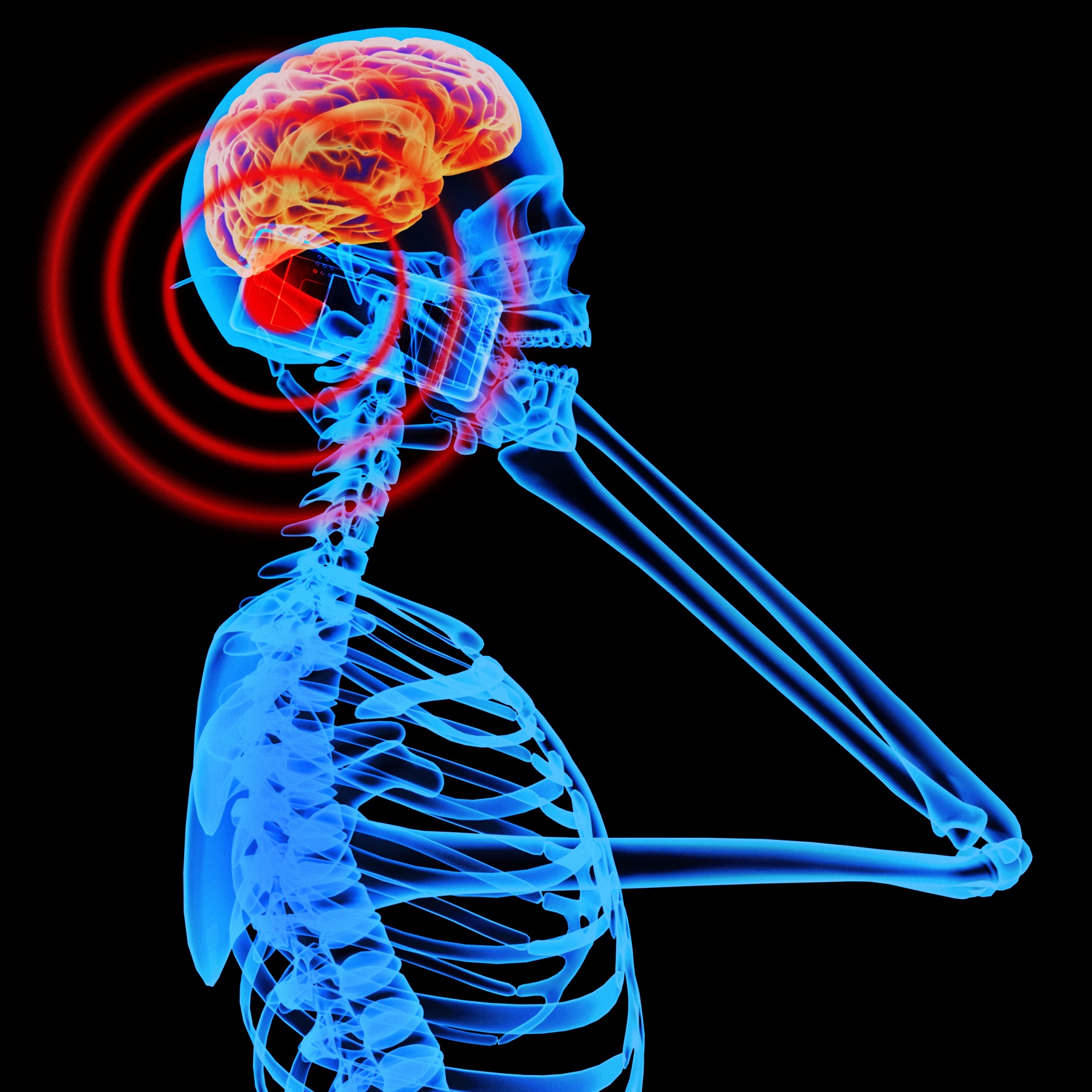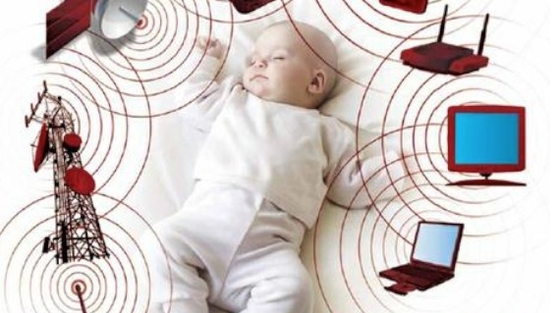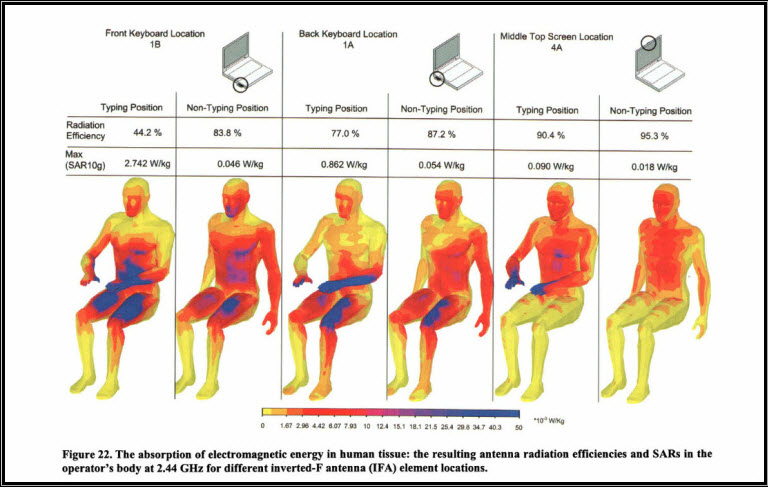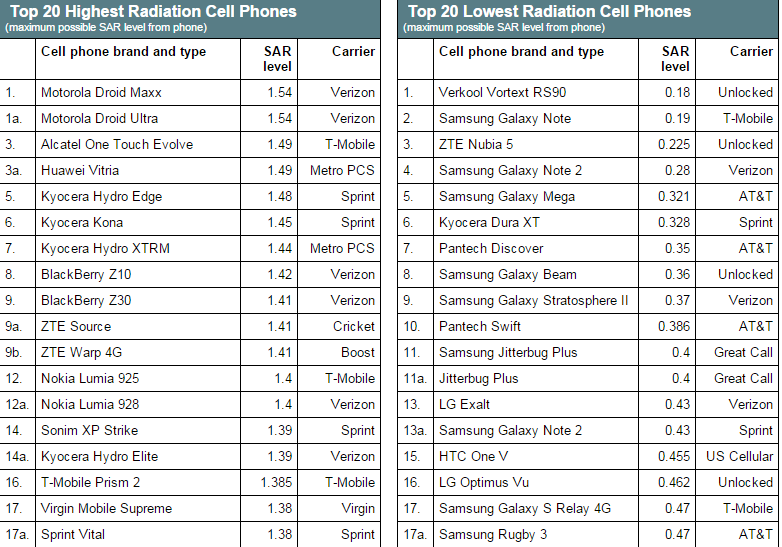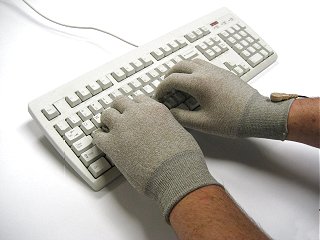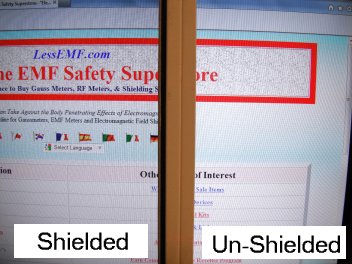Let’s be honest, the use of wifi and other technology products are going up every day. Daily, I receive notifications on new connected devices that monitor everything from my sleep to alerting me when my toast is done. Some families have 4-6 mobile phones with wifi signals in one home at any given time and that’s not counting all the emissions coming from their laptops, external wifi devices, wifi-enabled printers, microwaves, Smartphones, iPads, smart meters and more — all this under one roof.
While any one of these devices within a safe range from your body may not be alarming alone, the problem is the compound interest effect of the volume of devices around us on a regular basis. If you live in an urban area, it’s impossible to ignore them — people are talking on their cell phones in trains and buses, at airports and while you’re waiting in line for a coffee.
Wifi routers are in nearly every building in the modern world and often, there are dozens of them on one floor of a building alone, never mind the fact that the very same building may have a smart meter or several emitting harmful rays into your immediate environment as well. Couple that with microwave, iPad and laptop use in the home and we’ve got a growing problem. Let’s also remember that wifi router signals are getting stronger all the time and there’s more of them in smaller spaces, so it’s beyond time to say “enough already, my body needs a rest.”
Photo credit: www.healingthebody.ca
Electromagnetic field (EMF) emissions are real and as devices get more prolific and routers get stronger, we’re slowly frying our brains and roasting our bodies. If you think this exponential growth of EMFs constantly around us is a healthy thing and want to argue against all the science and medical “take care” warnings, be my guest, but even for the naysayers out there, read your cell phone manuals which warns you about putting the phone too close to our heads and yet…..most people do.
It’s still rare despite the press coverage, to find people using headsets. Even if I take precautions, just like second hand smoke is harmful to our health, so is second hand cell phone radiation, especially when everyone around us has one in use.
The problem is that it’s hard for our bodies to take a rest from all of the EMFs that are affecting our cells on a daily basis. This week, there were two girls texting on their cell phones in my gym’s SAUNA — yes, really, the SAUNA. In other words, texting and being “always connected” has become so addictive, that many people can’t put their phones down even for a 15 minute break in a sauna.
People check their phones at midnight before heading to bed, grab their phones when they first wake up, check them throughout the day and when they’re not checking them, they may be sitting close to their body organs in a chest or pant pocket and when they’re working out in the gym, they’re using them to track their steps or surf the web.
The only time the body is getting a break is when they’re sleeping and many people I know, including kids and teenagers, sleep with their cell phones ON (in other words, not in airplane mode, which shuts off those EMF emissions from attacking your body). To make things worse, there are now sleep monitors that require Internet connectivity close to your body at night while you’re sleeping. SO, when does the average American with a cell phone take a break from EMFs? If what I just described is you or close to you, then the answer is NEVER.
When I see photos of babies playing with an iPad, I shudder for a myriad of reasons. Exposing them to bright screens at such an early age tunes them into the addictive nature of technology before they can even speak and exposing them to whatever emissions are coming from the wifi-enabled device given their size is irresponsible in my opinion.
I’m not a doctor, a scientist or researcher, but even before I studied Anthropology in college so many years ago, I had always been a curious observer of people’s patterns for as long as I can remember. I see shifts in my own body and others around me on a regular basis and it’s not just because we’re all getting older. My friend Jeromy Johnson has dedicated a significant part of his life to educating people about the harmful effects of EMF emissions and who introduced me to the Less EMF website which was started by retired dentist Emil DeToffol.
Based in of all places upstate New York, Emil sells a host of products that help protect you from the negative effects of EMFs. While I know people who have real symptoms related to EMFs, Emil isn’t one of them and yet, he started this company in 1996, when there were few if any public conversations about the health hazards of electromagnetic field exposure. At the time, there was very little information and very few products available, but he felt that it was a real concern that was only going to get worse over time. And so, he started his business with only 3 products and grew from there and now they offer over 300 items, sourced from all over the world, from EMF meters and shielding of all kinds to educational resources like books and videos about EMF issues.
Says Emil, “even as a child I wondered about the effects of EMF on our bodies. When I asked my Dad how the music got into the radio, he explained about the waves in the air shaking the electrons in the radio’s antenna, and sending the music through the radio’s electronics. I intuitively knew then that the same process was happening in our bodies. While I am not electrosensitive myself, I am convinced by the volumes of scientific research that this biological effect is real and dangerous.” He also notes that his customers from around the world share the symptoms they have from EMF exposure, so he has real data from real people who have suffered a wide range of symptoms, from minor to severe.
The diagram below shows the absorption of electromagnetic energy on human tissue.
Photo credit: www.emfanalysis.com
Bottom line: even if we don’t have symptoms, could there perhaps be measurable changes in our bodies from EMF exposure? For those of you who care about your health and want to take precautions, here are some great product solutions from his site that I felt would be good “starts” for people who want to cover the basics. Note that some of these products I only just installed or implemented in my home, so my plan is to do a follow up article after using the products for awhile to report my findings.
In other words, I haven’t been using them long enough to provide more than the basics, but what I do know is that making this step was an important one and even in a short period of time, I appear to be sleeping better. Let’s get started!
ROUTER GUARD
Most homes today and certainly all offices have wifi routers and modems. If you’re going to use a wifi router near the people you care about, whether at work, school, or home, then why not shield it? The Router Guard is designed to dramatically reduce the radiation coming out of the router, while still allowing enough signal for connection.
It’s easy to use and inexpensive to buy. Here’s how it works! You simply put the router inside the Router Guard shield and the metal mesh provides plenty of cooling air circulation. Of course, with the weaker signal, you won’t get the same reach, which means you might even prevent your neighbors from mooching off your network — apparently it reduces your range by about half. This is because the 2-5% of the RF that gets out will enable you to get a small signal. As for size, it holds a router that is roughly 12 x 8.75 x 2.75 inches.
This may be an issue for those of you who stream videos from another room and need the signal to be stronger, however here’s a solution that seems to be working for us. While you’re slaving away in your home office or whatever room you spend most of your time surfing or working, keep the ROUTER GUARD on the modem…..later, if you need to ramp up the signal to watch a movie (those using Apple TV or Roku might qualify here), take the router out of the case or simply open it up for the two hours you need a stronger signal and then close it back up again before you go to bed.
This may also be an alternative for those wanting a stronger signal from their backyard or garden — just remember to store it back in the protective guard when you get back into the house.
The WiFi Router Guard is what’s called a “Faraday” cafe in electrical terms. It blocks external static and non-static electric fields by channeling electricity through the mesh, providing constant voltage on all sides of the enclosure. Faraday cages were named after the English scientist Michael Faraday, who first invented them as far back as 1836.
A Faraday cage operates because an external static electrical field causes the electric charges within the cage’s conducting material to be distributed such that they cancel the field’s effect in the cage’s interior (in this case, your modem). These cages cannot block static or low frequency magnetic fields, such as the Earth’s magnetic field. The reception or transmission of radio waves, a form of electromagnetic radiation, to or from an antenna within a Faraday cage, is heavily attenuated or blocked by a Router Guard.
As routers get stronger and stronger, it’s important that we protect ourselves and our loved ones. Personally, I think that every household should have a ROUTER GUARD to reduce the strength of emissions hitting us while we’re working close to a strong connection. How do you know how many emissions are coming from your router and other electronic devices in your home? Meet the High Frequency Meter, which we tested out. (BTW, our goal is to test out different rooms after we’ve had protective covers on things (and ourselves) for awhile, to see if there’s a measureable difference).
HIGH FREQUENCY METER
The HIGH FREQUENCY METER gives you feedback on the levels in your home or office. The device is a calibrated wideband (800 MHz – 2.5 GHz) RF meter with a switch that allows a choice of peak or average indication mode. This permits accurate measurement of both digital and analog signals and there’s a choice of audio tone – none, or intensity proportional to field strength, or proportional to frequency (for analyzing pulsed signals).
It should be no surprise that the meter’s signals went off the charts when placed near our flat screen TV, which like most homes, has a receiver, cable box and CD player underneath it in an entertainment unit. We also got an extremely high reading on the front patio, which is in close vicinity to a telephone pole with a “danger/voltage” sign on it. The highest of all was where we have the modem set up, which also has a wifi-enabled printer near it as well as two external RAID drives, which are also set up to communicate wirelessly.
The Less EMF website has plenty of other meters to choose from at a lower price point if you don’t want to go with a meter that is as extensive as this one, however, it really is a comprehensive meter for giving you the feedback you want about where signals are strongest in your home, so you can take proactive steps at diminishing those harmful emissions.
It is also a great meter for detecting the emissions coming from smart meters, which more and more homes are being “encouraged” to use. In our neighborhood, you have to pay MORE to keep your analog meter believe it or not…
For those not following the smart meter versus analogue meter discussion, read up as many are reporting negative health effects from being around them. A smart meter is a radiofrequency (RF) emitting device that the utility company has installed on your gas or electric meter. The RF signal emitted transmits information back to the utility company about your gas or electric usage. The signal is intermittent, but operates 24/7. Usually, the utility company will not permit you to completely block this transmission, however, you can shield your body and your living space to minimize the amount of RF exposure you receive.
If you are also concerned about the magnetic field emissions (due to the presence of electric current), see magnetic shielding material and the magnetic shielding FAQ. Apparently, RF reflectors and RF absorbers can also be used.
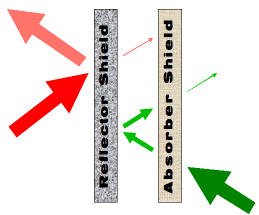
An RF reflector will cause the majority of the signal to bounce off, somewhat like a mirror reflects light. It can have very high shielding performance, and in general should be grounded for peak efficiency. It will usually offer better shielding (less RF transmission) than an absorbing material. An RF absorber will absorb the much of the signal, and minimize reflection.
According to the Less EMF site, “the energy absorbed is released as a tiny, almost unmeasurable amount of heat. Grounding is usually not needed. In both cases, SOME amount of RF does get through the shield, as no shield is 100% effective. You can use double or triple layers of shielding to improve performance.
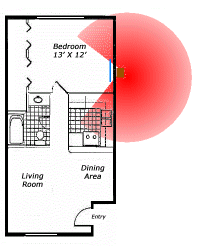
The shield must be positioned BETWEEN you and the source of the radiation. Generally, this means that the shield will be placed on the interior surface of the wall adjacent to the Smart meter. Think about the Smart meter emissions as coming from a light bulb located at the meter, and the shield casting a shadow.
You’ll want to cover enough wall so that the people would be in the protective “shadow” cast by the shield. Notice the small shield in the floor plan at right. In this example, the majority of the bedroom area is protected, but that is not true for the rest of the living space.
Some of them might be right inside your own home and others might be coming from other directions. In such a situation, if you use a reflecting material, it will reflect on BOTH sides, and you could end up increasing the amount of RF in your living space.
On the other hand, if you use an absorber, it will apparently absorb on BOTH sides, so you cannot increase your exposure. If, you use both materials, a reflector on the side closest to the RF source, and an absorber on the side closest to the living space, you get the best of both materials, and the absolute lowest RF transmission. Any small amount of Smart meter signal penetrating the reflector will be absorbed by the absorber.”
In every day English, the smart meter will tell you where in your home you need to be most concerned and the RF Reflector and RF Absorber will reduce what reaches you. Other meters available include AC Gaussmeters, DC Gaussmeters, Radiofrequency Meters, Electric Field Meters, Microwave Oven Leakage Meters and others.
The HARApad
Since nearly all of us use computers, the HARApad is a great heat and radiation attenuating pad for laptops. Laptops emit a high magnetic field from the base, and annoying heat and the HARApad is designed to act as a shield between magnetic field radiation source and the part of your body below the shield.
This is another product that should be a “must own” for anyone who has a laptop in my opinion, especially at its reasonable price point. While your kids are playing games or doing their homework on their laptop, wouldn’t you feel a little more comfortable knowing that they had a HARApad or object like it that helps reduce the EMF emissions?
A layer of high-tech radiation shielding material incorporated into the pad contains the field and reduces heat by increasing dissipation to the environment and away from your body and the laptop. It’s easy to use and inexpensive to buy – you simply place the HARApad under the laptop and its rigid polymer surface acts as a stable platform for both 15.4″ and 17″ laptops.
HARApad reduced magnetic fields more than 100%, which means that the magnetic fields were less than background levels with the shield in place. The pad is black on one side and gray on the other and weighs only 28 ounces.
We now use it while we are working on our laptops while sitting on the couch watching TV — while we didn’t test out a laptop protective shield, they do carry them and they are another smart idea if you’re a heavy laptop user. We are testing out an external monitor protector however (scroll down for the details).
ANTI-STATIC MAT
There’s also a nifty and flexible rubber mat, which is used for grounding. This pad is known to be used for static discharge and grounding of radiofrequency shelding. You can use it to ground your body, or to ground a piece of equipment like a laptop or keyboard, or apparently….both. This is what I learned from Emil who has been working with customers for years, so he has learned about a variety of ways people have found these products to be useful. Apparently, many people will sit on the mat, or put their feet on it or simply use it under a keyboard.
For me, using it under my keyboard made the most sense and may for you as well as a precautionary measure — it comes with a washable ex-static cover as well (pictured below). The rubber mat drains excess electricity which builds up in your body when it is exposed to EMF. In order to accomplish this, the excess electricity must have some where to drain off to.
Therefore, like all grounding, you need to connect the pad to a path to Earth. Examples of what could work include cold water pipes, radiator pipes, or a ground connection of an outlet, which allows electricity to flow to the soil (Earth). 
You can also simply touch the mat with any part of your body to dissipate electric field build-up and equalize your potential with ground and reduce static discharge problems.
It comes as a 12 x 12 size, however you can trim it with scissors to fit any area and it comes with a 5 foot grounding cord which is attached to it. If you want to ground to your electric outlet, you’d need to get a plug to gator ground cord.
AIRTUBE HEADSET
As my friend Jeromy Johnson is so fond of saying “Airplane Mode” is your friend and your other friend is the AIRTUBE HEADSET.
Although discussions have publicly commented on the dangers of holding a cell phone up to your head and manuals even alert you that it’s not a good idea, many people still don’t use a headset. Even if they do use a headset (which is better than not using one….the more distance from your head the better), that headset may not be doing much to protect them from EMFs. Radiation levels near the phone can be quite high and are higher on some smart phones than others. Using a headset to increase the distance from the phone to your head dramatically reduces your radiation exposure.
 See background information from the Federal Communications Commission hat shows what’s referred to as the SAR ratings of various cell phones. SAR stands for Specific Absorption Rate, which is a measure of the amount of radio frequency energy absorbed by the body when using a mobile phone.
See background information from the Federal Communications Commission hat shows what’s referred to as the SAR ratings of various cell phones. SAR stands for Specific Absorption Rate, which is a measure of the amount of radio frequency energy absorbed by the body when using a mobile phone.
Using an AIR TUBE headset has additional advantages in that no radiation can travel up the wire to the ear piece and there are no speakers or electronics (so no EMF) in the earpiece itself.
The chord is 39 inches long and has a built-in microphone — it’s much better than speaker phone mode as you can enjoy more privacy and obviously put the phone down and if you’re covering your phone with a Cruz case, then also in your pocket.
It works with a lot of phones but not all, so it’s important to check for compatibility before you order — apparently it generally does not work with Samsung phones. The headset comes in both black and white, making it a viable option for any cell phone. This is a must buy for anyone using a cell phone — if you’re going to use a headset, why not make it one that provides additional protection.
If you don’t think SAR ratings are real, take a look at data from 2014 that shows the highest and lowest SAR ratings for cell phones – is yours on the list? For iPhone users, the iPhone 5 with AT&T has 1.18, the iPhone 4S with Spring Nextel or Verizon is a 1.11.
Source: Lynn La and Kent German, “Cell Phone Radiation Levels,” www.reviews.cnet.com, Jan. 16, 2014
According to the SAFER EMR website, for both Apple iPhone 6 models, “the SAR level for the head is 1.18. When using a body-worn accessory to keep the phone five millimeters from the body, the SAR level is 1.18 for the iPhone 6 and 1.19 for the iPhone 6 Plus. (1, 2) Thus, the minimum separation distance that the phones should be kept from the body is approximately two-tenths of an inch (i.e., 5 millimeters).”
HOODIES & OTHER PROTECTIVE CLOTHING
Can clothing really provide you with protection you ask? The answer is yes, however some of the shielded clothing out there isn’t particularly attractive and may not fit into your normal every day life. I came across hoodies in both silver and brown on the Less EMF site that look and feel like a typical cotton hoodie, yet it’s made from very comfortable 90% Rayon and 10% Silver and tested to 90% or better RF attenuation over the frequency range from 1 GHz to 8 GHz.

In every day English, it means that it offers protection against harmful EMF emissions when you’re in close vicinity to them, i.e., working for long hours on your laptop is a great example or close to that powerful router. In addition, the high conductivity of silver causes Silverell to have antistatic behavior, plays an important role in minimizing body odor, and has a strong inhibitory effect on the growth of bacteria (actually acts as an antiseptic!). It can obviously be worn by both men and women and comes in S, M, L and XL.
Shielded gloves are great for those who either experience (or want to prevent) ES symptoms in their hands when using a computer keyboard, laptop, cell phone or other electronic devices. The gloves form a conductive enclosure and effectively shield radiowaves and electric fields.
While they may look silly to some of you who can’t imagine typing with gloves on, for those suffering from symptoms or want to avoid them if they’re heavy users, it’s a sub $20 solution that may provide a real benefit. The gloves are soft, light weight, have a ribbed cuff, and offer good tactile sensitivity to make it easier to type.
They use polyester fiber with pure Silver fibers, which is then knit into a stretchy glove shape in basic gray color. Each glove has a 1.7 mm snap for a ground cord and it’s also useful on touch screens like an iGlove.
COMPUTER MONITOR PROTECTION
You might think that some of this makes sense and remain skeptical about other reports and claims. Emil from Less EMF reports that he hears from customers all the time about their health issues from EMF and how products can in fact help. Bear in mind that no medical claims are being made here whatsoever; as a concerned citizen, I am doing a little research and trying to find out which products may be helpful. For me, I’m looking for minor shifts, like better sleep, less agitation from technology and EMF emissions and protecting myself from any negative impact that prolonged use could have on my body in the future.
Nearly all of us a laptop or have an external monitor plugged into one and yes, the screen on your laptop (or external monitor) is also sending off signals.
You can get fairly decent visibility through a highly transparent shield which we’re testing out now. They use a 40 dB VeilShield fabric for great RF and 100% E-field shielding, and depending on the size of your monitor, they can be custom made in any size up to 16″ x 28″. The shield can help reduce sensitivity to electric fields and includes a 6 foot ground cord.
The material on the shield is somewhat fragile, so you need to be careful putting it on. That said, after measuring the parameters of your monitor, you simply custom order a shielded screen that will afix itself to the plastic outside rim of your monitor. They include adhesive hooks and loops to make it easier to put on. Note: If you cover a touch screen, you cannot use the “touch” feature. Some Moiré pattern is inevitable, so it is apparently not recommended for high resolution work.
There’s a grounding chord attached to it, which you can simply plug into an outlet. I tried to capture some shots of the one I installed at home, but they merely came out on the dark side and didn’t really give an accurate “look” of what your resolution will look like.
Truth be told, yes, it’s obviously clearer and brighter without the shield — you do lose some of the clarity and some of your text may be a little grainy. That said, so far, I’m finding that I’m simply getting used to it — it isn’t that distinguishable for me to remove the shield and besides, the potential benefit of using it far outweighs a brighter more colorful screen. Obviously if I were to use that monitor for a professional photo show, it may not be all that useful, but for every day use, it’s perfect.
Bottom line here – do what you can to protect yourself, especially if you work on a computer for long hours, which the majority of people I know do.
If you’re interested in purchasing any of these products, click here for the large selection of what they have on offer.
USEFUL SITES & RESOURCES
- Less EMF: http://www.lessemf.com.
- EMF Analysis: Jeromy Johnon’s site, which has a wealth of articles and research about EMF effects: http://www.emfanalysis.com.
- SAR Ratings for a number of cell phone manufacturers: https://www.fcc.gov/encyclopedia/specific-absorption-rate-sar-cellular-telephones
- Collection of over 6,000 studies showing biological impacts from EMF pollution: http://justproveit.net/studies
- 2012 BioInitiative Report – References 1,900 new studies showing biological impacts from EMF: http://www.bioinitiative.org/
- Thousands of studies showing links between EMF pollution and biological effects: http://www.powerwatch.org.uk/science/studies.asp
- Electromagnetic Radiation Safety Website (Safer EMR: http://www.saferemr.com
Note: I write this entirely from a non-medical perspective. I am not making any claims for health benefits or that these products will solve issues that you feel may be related to EMF energy. I am simply a concerned citizen who has been learning more and more about the effects of EMF on our systems, both mentally and physically. The more I learn, the more I personally feel that doing whatever you can to reduce the effect of it is worth it. You should do your own research on products to see which ones might be useful for you.

Renee Blodgett is the founder of We Blog the World. The site combines the magic of an online culture and travel magazine with a global blog network and has contributors from every continent in the world. Having lived in 10 countries and explored nearly 80, she is an avid traveler, and a lover, observer and participant in cultural diversity.
She is also the CEO and founder of Magic Sauce Media, a new media services consultancy focused on viral marketing, social media, branding, events and PR. For over 20 years, she has helped companies from 12 countries get traction in the market. Known for her global and organic approach to product and corporate launches, Renee practices what she pitches and as an active user of social media, she helps clients navigate digital waters from around the world. Renee has been blogging for over 16 years and regularly writes on her personal blog Down the Avenue, Huffington Post, BlogHer, We Blog the World and other sites. She was ranked #12 Social Media Influencer by Forbes Magazine and is listed as a new media influencer and game changer on various sites and books on the new media revolution. In 2013, she was listed as the 6th most influential woman in social media by Forbes Magazine on a Top 20 List.
Her passion for art, storytelling and photography led to the launch of Magic Sauce Photography, which is a visual extension of her writing, the result of which has led to producing six photo books: Galapagos Islands, London, South Africa, Rome, Urbanization and Ecuador.
Renee is also the co-founder of Traveling Geeks, an initiative that brings entrepreneurs, thought leaders, bloggers, creators, curators and influencers to other countries to share and learn from peers, governments, corporations, and the general public in order to educate, share, evaluate, and promote innovative technologies.

